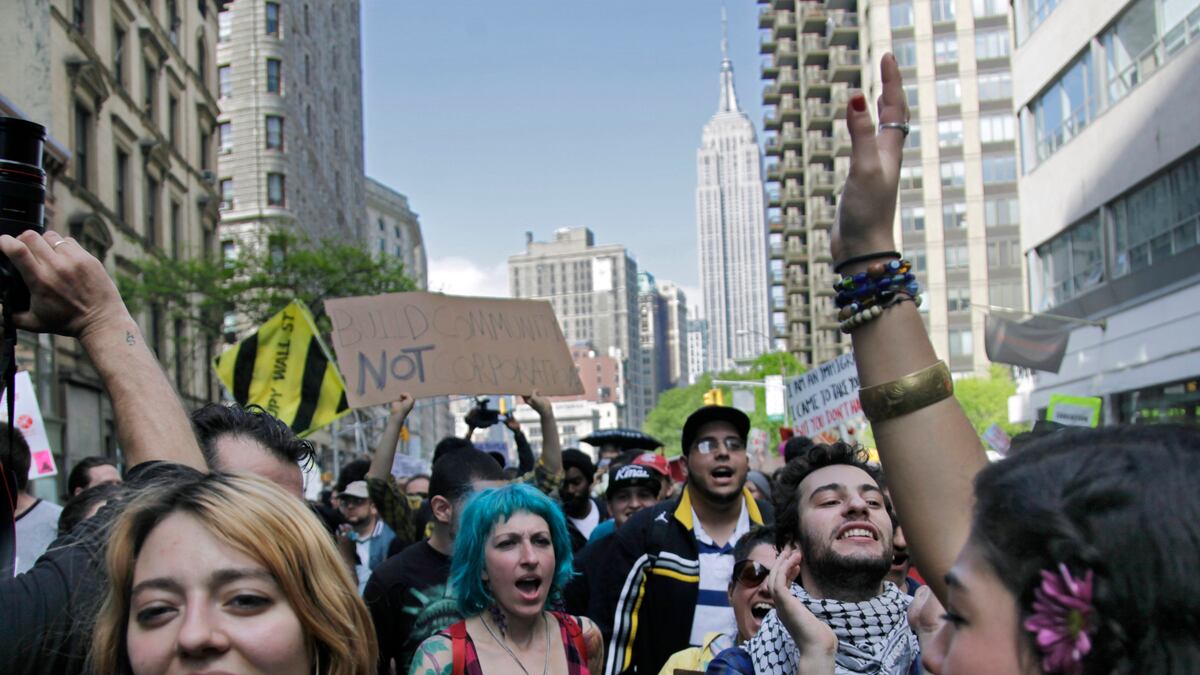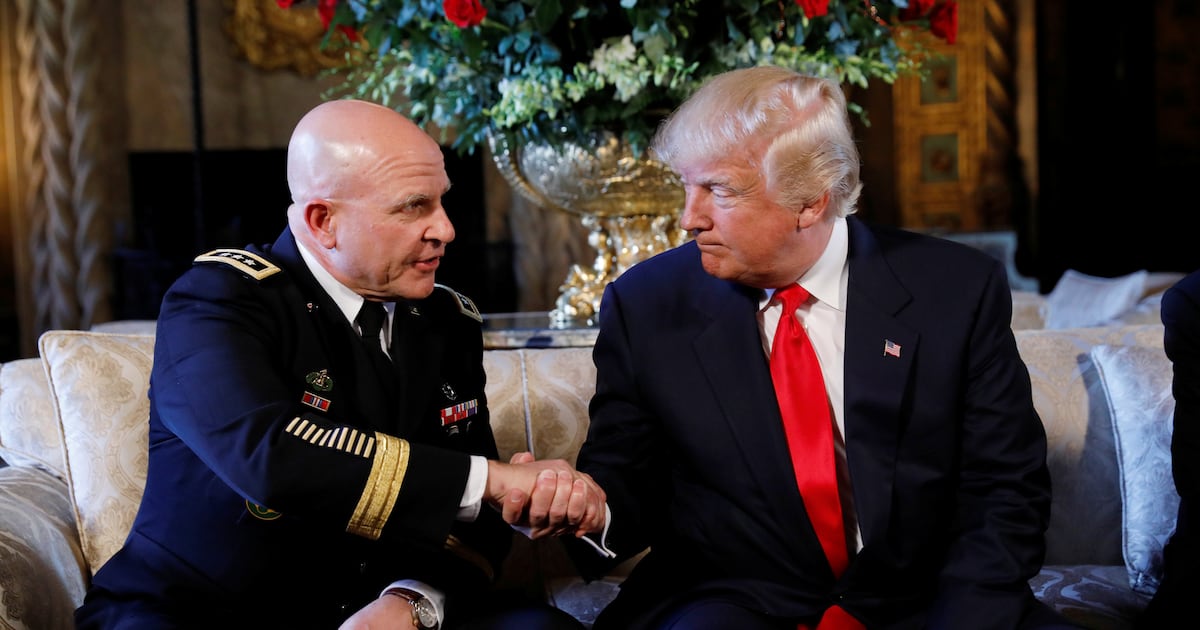Occupy Wall Street was back in force Tuesday in Manhattan, but questions remain as to what’s next for the protest movement. In a series of demonstrations planned across the city, supporters of Occupy joined with labor unions and immigration-rights activists to mount marches and pickets, culminating in a procession down Broadway to the Financial District that drew massive crowds.

The call to a day of action on May 1, recognized internationally as a day to celebrate labor, was also heard outside New York. Protesters took to the streets in Chicago and San Francisco, and abroad in London, Sydney, Barcelona, and other cities. Some of those protests turned violent. In Oakland, Calif., protesters clashed with law enforcement, and tear gas was used to disperse crowds. A few dozen black-clad protesters in Seattle raced through the city’s downtown and smashed shop windows.
The marches in New York went off with few incidents. They started slowly, with the main body of protesters gathering in the morning at Bryant Park in midtown. From there, groups of one or two hundred went to picket locations, including Bank of America.
Protesters said that they hoped May Day would be a moment of resurgence for Occupy Wall Street, which has mostly flown below the radar after its eviction from Zuccotti Park last November.
Cashwan Pratt, an 18-year-old Upper West Side resident, said he wanted “to see the shift from worried and privileged college students to workers who see they have a voice.” Pratt was one of about 30 protesters on bicycles who gathered at about 9 a.m. at Union Square, and then rode to protests around the city.
The number of protesters built slowly during the day, as Occupy supporters came in from New York’s outer boroughs and from smaller protests throughout the city. Justin Brown, 29, was with a group of about 300 marchers who gathered at Maria Hernandez Park in Bushwick, Brooklyn, before heading to Manhattan across the Williamsburg Bridge. The protesters were members of Occupy Williamsburg and Occupy Bushwick, two local Occupy offshoots. “There is a kind of latent underground community in Brooklyn that comes out when invited,” Brown said. At least three of those protesters were arrested on the march across, and the rest were met by dozens of police officers when they reached Manhattan.
The reinforcements from the outer boroughs, and from outside New York entirely, may be another sign that Occupy is growing horizontally. But more important for the sake of spectacle Tuesday were the unions, whose numbers helped swell the day’s main march to make it one of Occupy’s single largest protests since it emerged last fall.
Unions see the relationship between Occupy Wall Street and organized labor as mutually beneficial, said Charles Jenkins, the director for Transit Workers Union Local 100. “Unions have been complacent in recent years,” Jenkins said. “They agree Occupy Wall Street has been reenergizing the labor movement.”
Some fissures between Occupy and their allies were apparent. In the early afternoon, the protesters from Brooklyn raced up Broadway to Washington Square Park, deliberately running against traffic when possible, said Jordan McCarthy, a 22-year-old who used to live in Brooklyn but now works on a farm in New Hampshire. “It’s to show we’re not afraid and we have freedom,” she said of the traffic disruption strategy. McCarthy said she and her friends were protesting “the police and those who fund the police.
Unions take a different tact, said Nadya Stevens, an organizer for CWA Local 1180. “A lot of unions don’t participate in civil disobedience anymore—that’s not really what we do,” Stevens said. “Occupy Wall Street people do that now and then, and that’s fine. But a lot of our organizers won’t do that.”
The day’s main march drew thousands of protesters by most estimates, and traveled down Broadway from Union Square toward Bowling Green, at the southern end of the city. The march was led by five taxis from the New York Taxi Workers Alliance, and for most of the walk was led by a combination of union, Occupy, and immigrant-rights activists. As the crowd approached its destination, however, Occupy demonstrators began to take the lead, particularly as they passed Zuccotti Park. The march stopped entirely for several minutes as the crowd crossed the western entrance to Wall Street, as a number of protesters stopped and sat on the ground, resulting in at least one arrest.
The march ended by Bowling Green, and following a series of union speeches and dancing by the Wall Street Bull, groups of protesters began to splinter off or call it a day after 8:30 p.m.
There were a total of 30 arrests between the morning and 10 p.m. A group of more than 1,000 occupiers gathered at a park on Water Street to the east of Bowling Green after 9 p.m., where they held a meeting and discussed the possibility of trying to spend the night in the space. Police moved in at 10 p.m. and pushed most of the protesters out of the park with little resistance. As the crowd began to disperse, however, some groups pushed back against police directions, leading to a series of short sprints through the narrow streets. The police became more aggressive, precipitating several physical encounters, and made more arrests filling at least two transport vehicles."
The question of course remains of what Occupy will do with whatever momentum it picked up from Tuesday’s demonstration.
For some protesters, the lack of one or two key demands and a stronger organizational structure made the day less effective than it could have been. “I think they have to state their demands along with their actions,” said Anton Alen, a student at Hunter College, adding that he thinks Occupy Wall Street has been clear on many things it would like to see changed. Alen said that the idea of trying to occupy another space Tuesday night was in the right spirit but needed to be thought out better. “I don’t think it can be so spontaneous and still be effective,” Alen said.
Sofia Gallisa of Fort Greene, Brooklyn, disagreed. “This isn’t about specific demands,” she said. “It’s never been about specific demands.” Occupy Wall Street has changed the kind of discussions Americans are having about inequality, she said, particularly around issues of class.
As midnight approached, about 100 protesters were gathered back at Zuccotti discussing whether or not they should try to stay through the morning.





